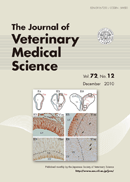Volume 72, Issue 12
December
Displaying 1-25 of 25 articles from this issue
- |<
- <
- 1
- >
- >|
Anatomy
-
Article type: FULL PAPER
2010Volume 72Issue 12 Pages 1597-1602
Published: 2010
Released on J-STAGE: December 29, 2010
Advance online publication: August 02, 2010Download PDF (1127K)
Avian Pathology
-
Article type: NOTE
2010Volume 72Issue 12 Pages 1637-1641
Published: 2010
Released on J-STAGE: December 29, 2010
Advance online publication: July 30, 2010Download PDF (691K)
Bacteriology
-
Article type: FULL PAPER
2010Volume 72Issue 12 Pages 1603-1608
Published: 2010
Released on J-STAGE: December 29, 2010
Advance online publication: August 04, 2010Download PDF (546K) -
Article type: NOTE
2010Volume 72Issue 12 Pages 1651-1653
Published: 2010
Released on J-STAGE: December 29, 2010
Advance online publication: August 06, 2010Download PDF (500K) -
Article type: NOTE
2010Volume 72Issue 12 Pages 1661-1663
Published: 2010
Released on J-STAGE: December 29, 2010
Advance online publication: August 11, 2010Download PDF (500K)
Clinical Pathology
-
Article type: FULL PAPER
2010Volume 72Issue 12 Pages 1575-1581
Published: 2010
Released on J-STAGE: December 29, 2010
Advance online publication: August 02, 2010Download PDF (741K) -
Article type: FULL PAPER
2010Volume 72Issue 12 Pages 1583-1587
Published: 2010
Released on J-STAGE: December 29, 2010
Advance online publication: August 02, 2010Download PDF (720K) -
Article type: FULL PAPER
2010Volume 72Issue 12 Pages 1609-1614
Published: 2010
Released on J-STAGE: December 29, 2010
Advance online publication: August 06, 2010Download PDF (548K) -
Article type: NOTE
2010Volume 72Issue 12 Pages 1643-1646
Published: 2010
Released on J-STAGE: December 29, 2010
Advance online publication: August 02, 2010Download PDF (611K) -
Article type: NOTE
2010Volume 72Issue 12 Pages 1655-1656
Published: 2010
Released on J-STAGE: December 29, 2010
Advance online publication: August 10, 2010Download PDF (942K)
Ethology
-
Article type: FULL PAPER
2010Volume 72Issue 12 Pages 1589-1596
Published: 2010
Released on J-STAGE: December 29, 2010
Advance online publication: August 02, 2010Download PDF (947K)
Immunology
-
Article type: FULL PAPER
2010Volume 72Issue 12 Pages 1565-1573
Published: 2010
Released on J-STAGE: December 29, 2010
Advance online publication: July 28, 2010Download PDF (973K) -
Article type: NOTE
2010Volume 72Issue 12 Pages 1629-1632
Published: 2010
Released on J-STAGE: December 29, 2010
Advance online publication: July 21, 2010Download PDF (670K)
Internal Medicine
-
Article type: FULL PAPER
2010Volume 72Issue 12 Pages 1551-1555
Published: 2010
Released on J-STAGE: December 29, 2010
Advance online publication: July 27, 2010Download PDF (597K) -
Article type: FULL PAPER
2010Volume 72Issue 12 Pages 1615-1619
Published: 2010
Released on J-STAGE: December 29, 2010
Advance online publication: August 10, 2010Download PDF (545K) -
Article type: NOTE
2010Volume 72Issue 12 Pages 1657-1660
Published: 2010
Released on J-STAGE: December 29, 2010
Advance online publication: August 11, 2010Download PDF (767K)
Parasitology
-
Article type: NOTE
2010Volume 72Issue 12 Pages 1647-1649
Published: 2010
Released on J-STAGE: December 29, 2010
Advance online publication: August 03, 2010Download PDF (545K)
Pathology
-
Article type: FULL PAPER
2010Volume 72Issue 12 Pages 1539-1545
Published: 2010
Released on J-STAGE: December 29, 2010
Advance online publication: July 21, 2010Download PDF (836K) -
Article type: FULL PAPER
2010Volume 72Issue 12 Pages 1557-1563
Published: 2010
Released on J-STAGE: December 29, 2010
Advance online publication: July 27, 2010Download PDF (955K)
Pharmacology
-
Article type: FULL PAPER
2010Volume 72Issue 12 Pages 1547-1550
Published: 2010
Released on J-STAGE: December 29, 2010
Advance online publication: July 22, 2010Download PDF (672K) -
Article type: FULL PAPER
2010Volume 72Issue 12 Pages 1621-1627
Published: 2010
Released on J-STAGE: December 29, 2010
Advance online publication: August 10, 2010Download PDF (815K) -
Article type: NOTE
2010Volume 72Issue 12 Pages 1633-1636
Published: 2010
Released on J-STAGE: December 29, 2010
Advance online publication: July 22, 2010Download PDF (706K)
Physiology
-
Article type: FULL PAPER
2010Volume 72Issue 12 Pages 1531-1538
Published: 2010
Released on J-STAGE: December 29, 2010
Advance online publication: July 20, 2010Download PDF (1078K)
Erratum
-
Article type: NOTE
Subject area: Bacteriology
2010Volume 72Issue 12 Pages E2
Published: 2010
Released on J-STAGE: December 29, 2010
Download PDF (454K) -
Article type: NOTE
Subject area: Bacteriology
2010Volume 72Issue 12 Pages E3
Published: 2010
Released on J-STAGE: December 29, 2010
Download PDF (439K)
- |<
- <
- 1
- >
- >|
